Brown dog tick
Dermacentor variabilis
Identification
Both males and females have eight legs and are typically brown to reddish-brown silver-gray markings on their scutum (back plate).
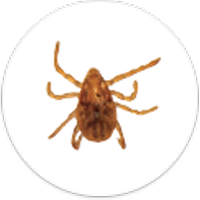
Nymph
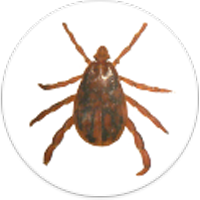
Male
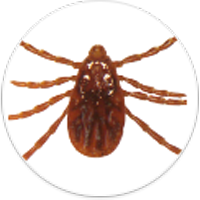
Female
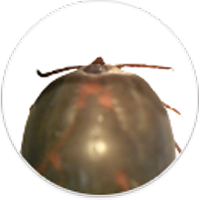
Engorged Female
Approximate Distribution
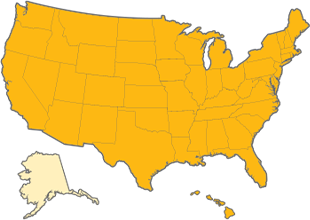
The brown dog tick is It’s more commonly found in warmer climates, but it can be found worldwide and is considered the most widespread tick species in the world.18
Hosts

As the name suggests, dogs are this tick’s preferred host. Larvae, nymphs, and adults prefer to feed on dogs but also feed on other small mammals.19
Habitat

The brown dog tick is notable because it’s one of the few ticks that can complete its entire life cycle indoors as long as a host (usually a dog) is present. Infestations can develop in residences and dog kennels.18
Diseases associated with Rhipicephalus sanguineus20, 22
Anaplasmosis
Anaplasmosis is caused by the bacteria Anaplasma phagocytophilum. It primarily affects dogs (infection in cats is rare). Dog with anaplasmosis may never show signs of illness or require treatment. Those that do commonly respond to antibiotics.23
Clinical Signs
In dogs:23
● Fever
● Decreased energy
● Decreased appetite
● Dehydration
● Some dogs may show no signs
Diagnosis and testing
To diagnose anaplasmosis, your veterinarian will usually use a blood test to detect antibodies. In some cases, a positive antibody test might indicate previous exposure, rather than an active infection needing treatment.23
Treatment
The antibiotic doxycycline is commonly used to treat anaplasmosis. Dogs often start to feel better in one or two days after starting antibiotics, but treatment should continue for at least two weeks. If a dog tests positive for the antibody but shows no signs of the disease, antibiotic treatment is not required.23
References:
23. Anaplasmosis. Cornell Richard P. Riney Canine Health Center. https://www.vet.cornell.edu/departments/riney-canine-health-center/canine-health-information/anaplasmosis
Babesiosis
Babesiosis is a potentially fatal disease that can affect a wide range of animals, including pets and humans. In pets, it can be caused by the organisms Babesia canis and Babesia gibsoni.24
Clinical Signs
In both dogs and cats:25
● Fever
● Decreased energy
● Weakness
● Loss of appetite
● Jaundice
● Weight loss
Diagnosis and testing
Veterinarians diagnose babesiosis using several methods, including a physical examination, a detailed medical history, and microscopic evaluation of blood. They may also use advanced techniques to test for the genetic material of the Babesia organism or to identify antibodies produced in response to Babesia to help determine the infection’s presence and severity.25
Treatment
The treatment of babesia is often dependent on what species of Babesia is present in your dog. Treatments may include antibiotics (azithromycin or clindamycin) and/or anti-fungal/anti-parasitic medications like atovaquone or Imizol® (imidocarb). Dogs may also get supportive care, such as intravenous fluids.26
References:
24. Blood Parasites of Dogs. Merck Vet Manual. https://www.merckvetmanual.com/dog-owners/blood-disorders-of-dogs/blood-parasites-of-dogs
25. Babesiosis in Animals. Merck Vet Manual. https://www.merckvetmanual.com/circulatory-system/blood-parasites/babesiosis-in-animals
26. Babesiosis in Dogs. VCA Animal Hospitals. https://vcahospitals.com/know-your-pet/babesiosis-in-dogs
Cercopithifilaria
Cercopithifilaria is a parasite that causes infection in dogs.30
Clinical Signs
The main clinical sign of Cercopithifilaria infection in dogs is skin inflammation or skin lesions.30
Diagnosis and testing
Cercopithifilaria infection is diagnosed by taking a biopsy (skin sample) from the dog to confirm the presence of the parasite and to help guide treatment.30
Treatment
Dogs infected with Cercopithifilaria may receive topical treatment with the parasite-control drugs moxidectin and imidacloprid.30
References:
30. Cercopithifilaria spp. of dogs: little known but prevalent filarioids beneath the skin. Biomed Central. https://parasitesandvectors.biomedcentral.com/articles/10.1186/s13071-023-06007-5
Ehrlichiosis
Ehrlichiosis is a serious disease caused by the Ehrlichia bacteria. It affects both dogs and cats.33, 34
Clinical Signs
In dogs and cats: 33, 34
● Fever
● Swollen lymph nodes
● Loss of appetite
● Depression
● Muscle stiffness
● Coughing
If the disease progresses, long-term signs include bleeding and bruising caused by low levels of platelets in the blood.
Diagnosis and testing
Diagnosing ehrlichiosis involves a combination of observing clinical signs and conducting blood and laboratory tests, which help confirm the presence of the Ehrlichia organism and assess the severity of the infection.33, 34
Treatment
The primary treatment for ehrlichiosis in both dogs and cats typically involves the use of doxycycline, an antibiotic. It can also include supportive care to address symptoms and keep your pet more comfortable.35
References:
33. Ehrlichiosis and Related Infections in Dogs. Merck Vet Manual. https://www.merckvetmanual.com/dog-owners/disorders-affecting-multiple-body-systems-of-dogs/ehrlichiosis-and-related-infections-in-dogs
34. Ehrlichiosis and Related Infections in Cats. Merck Vet Manual. https://www.merckvetmanual.com/cat-owners/disorders-affecting-multiple-body-systems-of-cats/ehrlichiosis-and-related-infections-in-cats
35. Ehrlichiosis, Anaplasmosis, and Related Infections in Animals. Merck Vet Manual. https://www.merckvetmanual.com/generalized-conditions/rickettsial-diseases/ehrlichiosis,-anaplasmosis,-and-related-infections-in-animals
Hepatozoonosis
Hepatozoonosis is a disease caused by Hepatozoon parasites. It affects both cats and dogs, with varying severity. In cats, the disease can range from asymptomatic (showing no signs) to potentially life-threatening. In dogs, it can be severe to fatal if not properly managed.36, 37
Clinical Signs
In dogs:36
● Fever
● Weight loss
● Poor body condition
● Muscle atrophy
● Pain
● Weakness
● Eye discharge
Cats rarely show any clinical signs of infection.37
Diagnosis and testing
For dogs, diagnosis usually involves an evaluation of the dog’s clinical signs and medical history as well as x-rays and blood, tissue and other types of laboratory testing. In cats, diagnosis is challenging because cats rarely show signs of the disease, but the disease can be diagnosed by identifying the parasite within blood samples or by other laboratory tests.36,37
Treatment
Hepatozoonosis in dogs is generally considered a lifelong infection. Treatment usually involves medication, supportive care, and the use of tick control products. No known treatment completely clears animals of the organisms.37
In cats, the condition may be difficult to treat, but several drugs have used successfully.37
References:
36. Old World Hepatozoonosis and American Canine Hepatozoonosis. Merck Vet Manual. https://www.merckvetmanual.com/circulatory-system/blood-parasites/old-world-hepatozoonosis-and-american-canine-hepatozoonosis
37. Blood Parasites of Cats. Merck Vet Manual. https://www.merckvetmanual.com/cat-owners/blood-disorders-of-cats/blood-parasites-of-cats
Rickettsiosis (spotted fever group)
Spotted fever group Rickettsiosisis a group of diseases caused by various species of the Rickettsia bacteria. They can affect both cats and dogs, though cats generally show no symptoms and may have been infected by contact with fleas, not ticks.38, 39
Clinical Signs
In dogs:38
● Fever
● Loss of appetite
● Swollen lymph nodes
● Painful joints
● Coughing
● Vomiting
● Diarrhea
● Swelling of face or extremities
Diagnosis and testing
To diagnose a dog, your veterinarian will likely use a combination of observing the signs and conducting blood and laboratory testing.38
Treatment
Treatment typically involves the use of the antibiotic doxycycline. In addition to medication, your pet may receive supportive care and careful monitoring to help manage symptoms and ensure well-being.38
References:
38. Rocky Mountain Spotted Fever in Dogs. Merck Vet Manual. https://www.merckvetmanual.com/generalized-conditions/rickettsial-diseases/rocky-mountain-spotted-fever-in-dogs
39. Flea-borne Rickettsiosis. Companion Animal Parasite Council. https://capcvet.org/guidelines/flea-borne-rickettsiosis/
References:
18. Featured Creatures: Brown Dog Tick. University of Florida. https://entnemdept.ufl.edu/creatures/urban/medical/brown_dog_tick.htm
19. Geographic Distribution and Seasonality of Brown Dog Tick Lineages in the United States. Journal of Medical Entomology. https://academic.oup.com/jme/article/60/1/102/6808325
20. Ticks. Companion Animal Parasite Council. https://capcvet.org/guidelines/ticks/
22. Detection of Cercopithifilaria bainae infection in shelter dogs and ticks in Oklahoma, USA. Biomed Central. https://parasitesandvectors.biomedcentral.com/articles/10.1186/s13071-020-04089-z

 Austria
Austria Belgium
Belgium Czech Republic
Czech Republic Denmark
Denmark Europe
Europe Finland
Finland France
France Germany
Germany Greece
Greece Hungary
Hungary Ireland
Ireland Israel
Israel Italy
Italy Netherlands
Netherlands Norway
Norway Poland
Poland Portugal
Portugal Romania
Romania Spain
Spain Sweden
Sweden Turkey
Turkey United Kingdom
United Kingdom United States
United States